1991 Spanish Grand Prix
Prolonging the dream
As a venue we feared the worst, worried that, literally, it might have nothing; as a race, it had it all. The 1991 Spanish GP was one of those épreuves for which all the portents looked bad. It was being held on a new circuit, and as with all circuits, construction was running behind schedule. Towards completion date, the slightest rain shower would multiply delays. When they held a club race to inaugurate the Circuit de Catalunya two weeks before the GP, there were no telephones and there was no running water. Days before, that was finally provided in the form of dramatic rain storms.
Despite all that, the event came through on the day. Everything worked perfectly (even the phones!) and it was impossible to argue with a logic that had taken the race from the sherry wasteland of Jerez and transported it to within 50 kilometres of that thriving metropolis, Barcelona. No, it wasn’t as breathtakingly spectacular a venue as the old Montjuich Park, now sadly foundering beneath a welter of pre-Olympics construction. It was, however, a deal more toothsome than Jerez. Over the weekend the estimates spoke of 70,000 paying punters, which made a crowd around 69,500 greater than anything the Spanish GP has seen for the last six years. It made a change not to be on nodding terms with everyone in the grandstand.
All the effort — and it had been considerable — was rewarded with a superb race that left the World Championship still open as the teams headed for the final races at Suzuka and Adelaide.
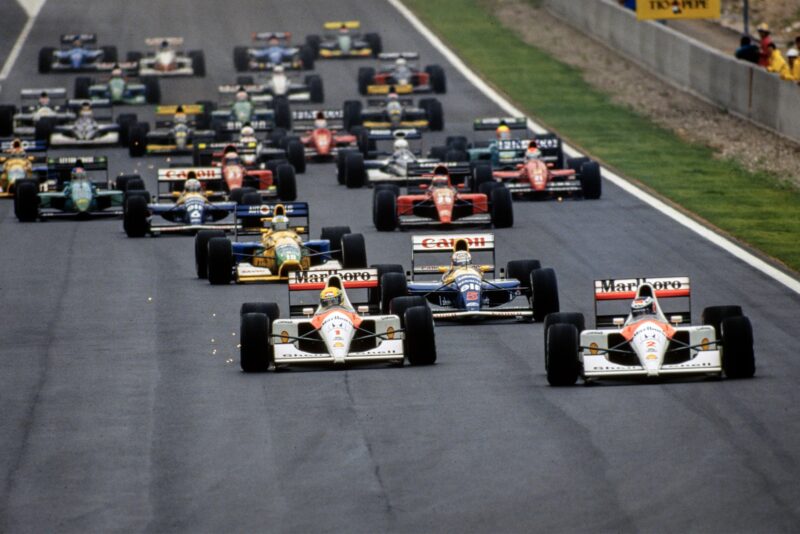
Gerhard Berger leads the field approaching the first corner
Motorsport Images
You can tell an awful lot about a driver’s mentality from observation of his style and Catalunya’s weather conditions, allied to a circuit that drew general praise for its layout, magnified perceptions splendidly. The start was one of those affairs in which anything could happen, since a massive engine failure for Senna during Saturday afternoon’s qualifying session had left one with the feeling that very few of the front runners had really got into their stride. The grid was not, perhaps, fully representative of form. Berger had taken pole the hard way, and looked the stronger of the two McLaren drivers for the second week in succession, which in itself was unusual. Mansell had joined him on the front row, leaving the unhappy Senna third and Patrese fourth ahead of the upstart Michael Schumacher and the two Ferraris. To complicate matters further, it was wet on race day, and although the skies were lightening perceptibly as the start neared, it was declared an officially wet race. Without exception, everyone started on wets, but in the cockpit of Ferrari number 27 Alain Prost was already fuming.
“We have such stupid pressure on us here,” he seethed of the lamentable Ferrari management, “that they said they didn’t have time to change my car to slicks. If I had had them, I could have won. It would have been the only way that I could have, but it would have been a chance.” In the best pit stops all four wheels and tyres can be changed in less than six seconds. With five minutes to go before the start, Prost had an undeniable point to his latest criticism. Perhaps it was just a case of staff shortage, for it was noticeable how little attention the team appeared to be paying the man who won them five races — and damn nearly the World Championship — last season . . .
Berger and Senna outdragged Mansell down the long, long La Caixa straight and into Elf, the right, left flick at the end of it. Senna even had a peek down the inside of his team-mate, but on this occasion Gerhard moved confidently over to discourage the manoeuvre. It was another indication of the subtle turn events had taken in the McLaren camp in the last two races. Berger was quite frank about it.
“I had a bad beginning to my season in Phoenix,” he admitted freely, looking markedly more relaxed than at any stage so far in 1991. “It knocked me. I had done a lot of testing, more than ever before. When you’re testing everything seems okay, but you get used to 95%, and when you come to race, you can be in trouble because of that!
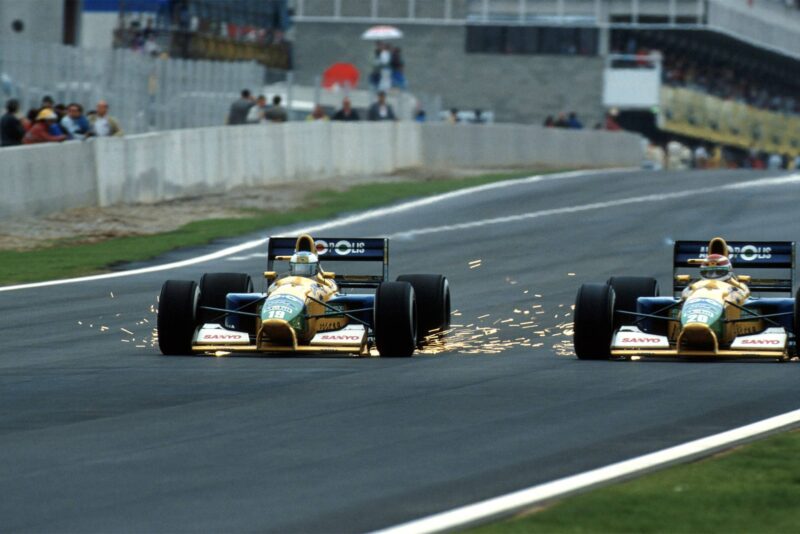
Rookie Michael Schumacher makes a move on world champion team-mate Nelson Piquet
Motorsport Images
“If I’m honest I can still say I don’t really know what went wrong for me, but now I’m feeling relaxed, very good.”
Senna, by contrast, looked shaky all weekend, a quite remarkable development. In qualifying he had even admitted to lacking commitment, which would have been tantamount to heresy had anyone else voiced the thought, but it showed the way the World Champion’s mind was working. Stay out of trouble, take minimal risk. Let the championship come, don’t try to force it.
It was on Mansell’s broad shoulders that the pressure should have been the greatest, for after the disaster of Estoril he had it all to do. Yet in the race the Briton was nothing short of superb. Prior to it, off-track, it had been a different story, with a ‘friendly’ football match turning bad-tempered and then further spleen-venting acrimony between him and Senna during the drivers’ briefing on race morning.
As Senna eased ahead of him on that first lap, Mansell then came under dramatic pressure from Schumacher, whose soft Pirelli wets were working very well. The German scythed up to third, took second side-by-side with Senna for one corner, and remained a potential spoiler until the track began to dry. Mansell watched him with detached interest, aware that he has not raced with him often enough to trust him totally and, like Senna, mindful that he had to finish at all costs.
It didn’t take him long to work back on to Senna’s tail, as Berger built up a healthy advantage, and it was a racing brain working at its optimum. On lap four he took a brief look down the inside of Senna into Elf, but didn’t quite have the momentum. A lap later he ducked out of the MP4/6’s slipstream earlier, and the Williams and the McLaren ran side by side. Normally such incidents last but moments, but this one was prolonged deliciously. With sparks scraping from their undercar skidplates the two fastest drivers in the business sat it out alongside one another at 195mph, neither prepared to give an inch. It was Grand Prix racing just as it should be, and to their lasting credit neither of them let their morning altercation affect their conduct on the track. The advantage was fractionally with Mansell, but as he dived ahead Senna counter-attacked as they negotiated the left-hand section of Elf. Tactically Mansell ran a little wider than he might otherwise have done, and as Senna, on the outer line, had to move wider still and lost momentum, the Williams was away.
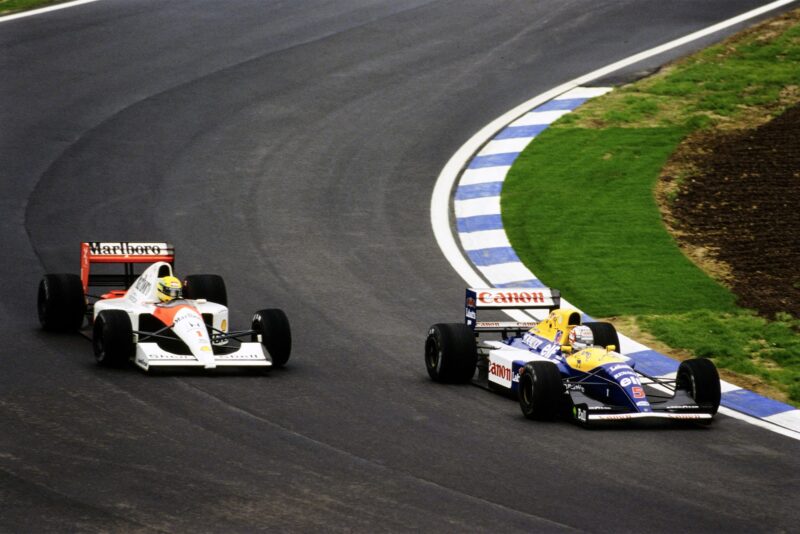
Nigel Mansell and Ayrton Senna go wheel-to-wheel
Motorsport Images
Berger, meanwhile, was still happily leading, but after a moment Schumacher was recovering and moving up again to threaten Senna and Mansell in a performance that doubly underlined his commitment. It is fashionable when a new driver appears and immediately threatens his peers to hail him as the new X or the new Y. Some were carried away with Jean Alesi last year, only to be disappointed this season. Suffice it to say, however, that the manner in which Schumacher attacks, throws his car around in slides even in the dry, and refuses to give up bears nascent hallmarks of Villeneuve and Bellof.
If pit stops were crucial in Estoril, they again played their role in Barcelona, and after Berger had been delayed badly having the tape removed from his front brake ducts after stopping for slicks on lap nine, Mansell and Senna came in together a lap later. They did not leave at the same time. Senna was down at the end of the pit road before the Williams crew got their man underway, but that was understandable. Mansell was relieved simply to leave on four wheels, he said.
This was where Senna’s race came apart. Up until this point the Brazilian had looked aggressive enough, prepared to leave victory to Berger and to concentrate simply on keeping Mansell in sight. That he had been doing very nicely. Now, however, for the second race running he had gone against the advice of Goodyear on his tyre choice, opting to be conservative. He would pay dearly. All of Akron’s other runners switched to softer Ds all round, but Senna wanted harder compound Cs on the left-hand wheels, just to be sure. It was a mistake.
The extent of that error became obvious as Berger, who had rejoined just behind Senna, soon eased back into the lead on lap 12. By then Mansell and Schumacher were in Ayrton’s wheetracks, their softer rubber eating into his slender advantage. When he spun coming on to the main straight at the end of lap 13 it was both uncharacteristic and dramatic, for as the McLaren looped towards the pit wall he had the brakes hard on, and even before the full momentum had been exhausted he had hooked reverse and shot back across the track, on to the outfield. In doing so he narrowly missed Mansell, who scraped through on the outside, and Schumacher, who thus had a clear inner line for which to aim. It was cool-headed car control par excellence, and being Senna the luck was with him as he regained the track. The outer edge run-off areas in Spain were crushed lava, and afforded drivers sufficient grip to recover so long as they kept their engines running. He rebuilt his momentum on the run down La Caixa, leaving a trail of pebbles, but had dropped to sixth behind Prost and Piquet as well and thereafter never looked a threat.
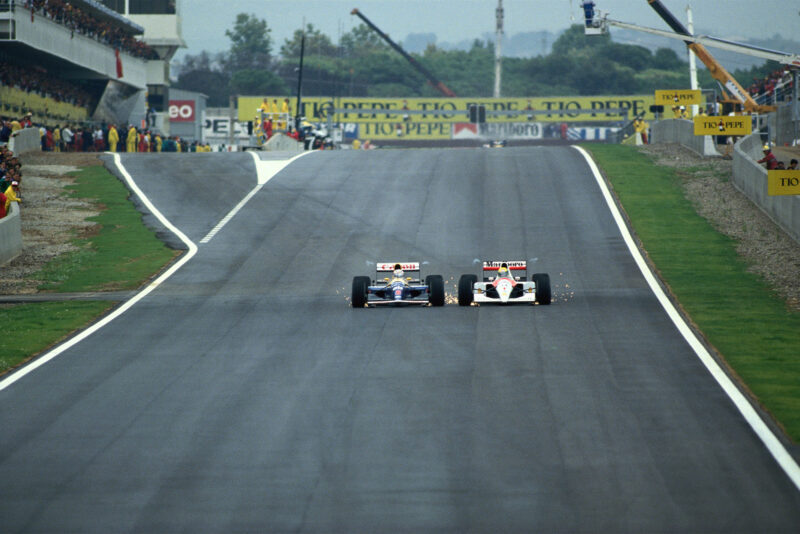
Sparks fly as the Mansell and Senna fight for position
Motorsport Images
Mansell immediately set about closing the gap to Berger, even when a light drizzle raised pulses momentarily and prompted unrealized fears of further pit stops. On lap 21 he forced Gerhard into a mistake at the end of the straight, inducing the Austrian to overbrake to try and protect his line. The McLaren’s back end stepped out of line, the front slid wide as Gerhard corrected, and with the momentum temporarily interrupted, Mansell was away. All he then had to do was pace himself, deal with the backmarkers — Brundle in particular caused him problems at the 43 lap mark — and pray that the Williams-Renault would be reliable all the way to the finish. It was.
The same could not be said of Berger’s McLaren. Just as it seemed that his luck might be turning, he chugged into the pits at the end of his 33rd lap, to retire with a misfire suspected to emanate from one of the coils.
At that stage Senna was still third, in for a useful four point bonus. Prost, who’d been badly compromised at the start by the antics of team-mate Alesi, had lost many places in the traffic and then stopped for the slicks he’d wanted from the start on his third lap. After that the Ferrari was flying, rather embarrassing those who have accused the Frenchman of being past it in recent months. The 643 was closing on Berger’s McLaren when it retired, and keeping Mansell honest, but rather than the Ferrari posing a threat to the leading Williams, it was more a case of the second FW14 posing a threat to the Ferrari. After narrowly avoiding the second lap waltz between Emanuele Pirro and Ivan Capelli sixth and seventh at the time Riccardo bided his time but gathered pace as the race unfolded. Both Williamses had made a concession to the wet by running Gurney flaps on their rear wings, which hurt them slightly on top speed, but Riccardo got steadily faster and was catching Prost as the race moved into its final phase. At the same time, Alesi was pounding along in the second Ferrari, chasing after him.
It took the organisers a long time to adjudge the matter of the Frenchman’s startline tactics, which saw him weaving but no more dramatically than had Mansell, Martini or Schumacher in Estoril, but eventually the word filtered through of a stop-and-go penalty. It coincided with a dramatic phase in Jean’s challenge to Senna, and after he charged into the pits on lap 29 and dropped from fifth to ninth he drove that 643 with finely controlled anger. Steadily he eroded the gap to Senna, who had already succumbed to Patrese’s challenge on lap 38. Indeed, that had been a strange sight, for Ayrton appeared to have the corner and the momentum, but left Riccardo the sort of gap that could not be refused. In one neat outbraking move the Williams gained a place and Ayrton conceded a point.
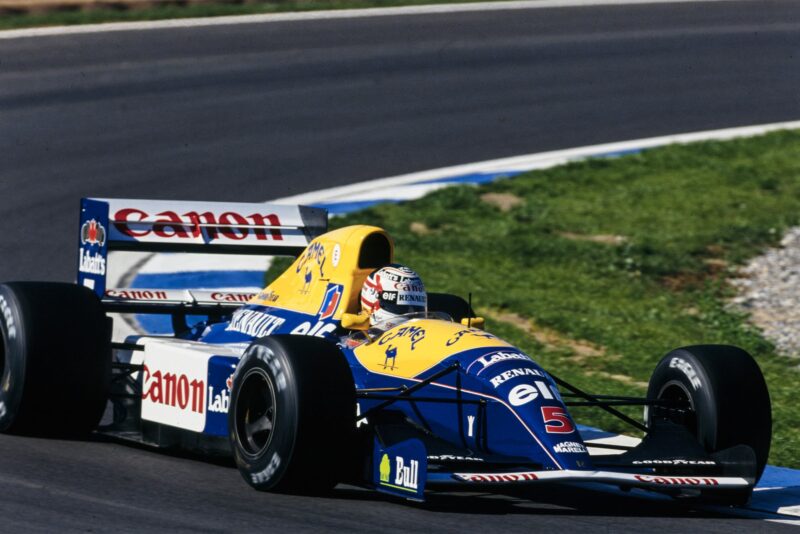
Mansell on his way to victory
Motorsport Images
He finally lost another on lap 50 when Alesi’s dogged pursuit caught him by surprise at Elf. As he moved over to claim his line he found Alesi already there, the Ferrari kissing the inside edge of the kerb. Senna had to brake and move left in a hurry, and after that Jean was gone. It was a bit of solid opportunism by the latter — perhaps Ayrton has forgotten Phoenix 1990 — and another indication of how alien it is to his psyche to drive for points. Spain was the nearest he has ever come to a lacklustre race, the spin recovery notwithstanding, and afterwards he pledged to be less timid at Suzuka. Watching him driving against his natural attacking instincts at Barcelona was like watching a fish trying to fly.
In the end Patrese’s chase of Prost failed by a little over four seconds, and Alesi’s of Patrese by just under seven, as Mansell scored his 21st success 11 seconds clear of Alain. It was a masterful drive in which, as Senna and Berger erred, he could truly have been said not to have put a wheel wrong. Afterwards we heard the familiar tune, as he limped in on his football-injured ankle and spoke hoarsely of his developing laryngitis. No Mansell finish ever seems quite complete these days without some medical ailment.
As the track dried out Pirelli’s shortcomings became more evident and Schumacher made so many stops it prompted one to ponder the feasibility of Benetton equipping its cars with two sets of wheels at a time. Sixth place was a poor reward for a sterling performance. Nelson Piquet, once again firmly outclassed by the newcomer, was similarly delayed and slumped to an unhappy 11th, right on the tail of poor Brundle. Martin drove a blinder in Spain as he pulled the Brabham up into sixth place for one tour on lap 14, and thereafter worked it steadily back up to seventh in a heady battle with JJ Lehto’s Dallara. It was during the course of that, as he moved ahead of the Finn, that he incurred Mansell’s wrath as the latter tried to lap them. The need to stop right near the end for another set of Pirellis finally killed his chances of a championship point, and left him in the wake of Gugelmin, Lehto and debutant Alessandro Zanardi. The latter performed well enough for Jordan as Roberto Moreno’s replacement, without ever reaching the heights scaled by Schumacher at Spa.
Gabriele Tarquini benefited from a game of musical chairs which saw Olivier Grouillard fired by Fondmetal and Gabriele hired in his place. He took the neat Fomet 1 to a welcome 12th place finish, as Grouillard, taken on in Tarquini’s old AGS seat, failed to prequalify. Behind the Fomet, Martini limped his Minardi home with severely damaged right-hand rear suspension, the legacy of an attack by team-mate Morbidelli who had gone off the road trying to pass Zanardi, and shot back on to it just in time to hit his sister M191! Another appalling outing saw the two Tyrrells trailing at the back, finishing in such miserable 16th and 17th places that one wondered what on earth had happened to the promise there had been at the beginning of the season when Ken Tyrrell had started out with Honda engines and an improved version of the 019 chassis that had been so electrifying in Alesi’s hands last year. It didn’t help that Modena misjudged the weather and, having switched to slicks just before the drizzle on lap 12, came in again for more wets only to see the conditions improve again almost immediately.
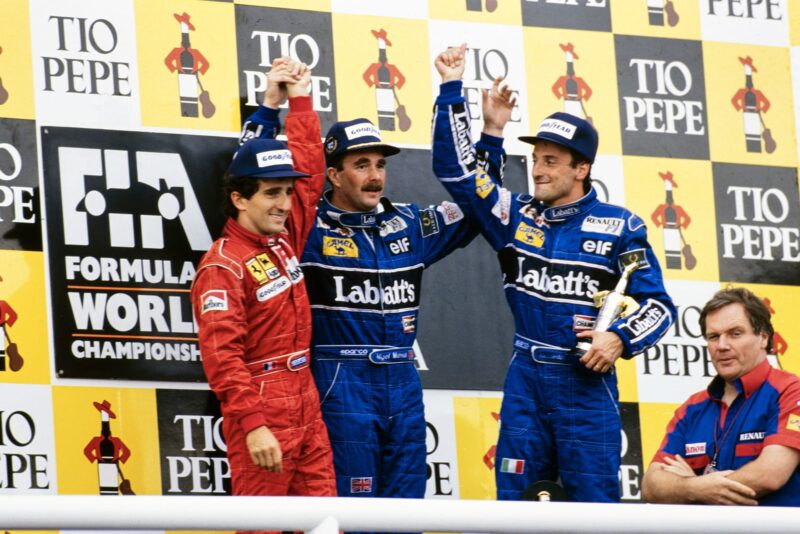
Mansell raises the arms of runners-up Alain Prost and team-mate Riccardo Patrese
Motorsport Images
In Spain there was again much speculation that Alain Prost might join Ligier in 1992 (Prost himself continued to say absolutely nothing on the subject), and if he does it is unlikely that Erik Comas’ performance will have been overlooked.
Once again the 1990 F3000 champion marginally outqualified team-mate Thierry Boutsen, but where the Belgian was a first lap casualty after hitting Eric Bernard’s Lola, Erik was in superb form. In the damp morning warm-up he had signalled his intentions with fourth fastest time, prompting somebody to suggest that the Ligier JS35B probably has more grip in the wet than it does in the dry.
From 20th on the opening lap, he decimated the field like a burst of napalm, rising to sixth by lap eight, only partly as a result of others pitting in front of him. Sadly an electronic problem on the Lamborghini V12 then doomed his efforts to failure, but it had been a perhaps timely reminder of his ability after an unhappy season trying to make the bulky blue car work.
If one Frenchman was stymied, others weren’t, for Renault’s men left Spain rubbing their hands and relishing a hard-won single point lead over McLaren Honda in the Constructor’s Championship. For Mansell, the 16 point deficit to Senna might have seemed like a mighty mountain to scale, but for his team the very summit was in tantalising sight. — DJT
***
Results (top five), Spanish GP, Barcelona, Montmelo, September 29
65 laps of 4.747 km circuit (308.555 km; 191.727 miles)
1. Nigel Mansell, GB, (Williams FW14 – Renault V10) 1h 38m 41.541s
2. Alain Prost, F, (Ferrari 643 – Ferrari V12) 1h 38m 52.872s
3. Riccardo Patrese, I, (Williams FW14 – Renault V10) 1h 38m 57.450s
4. Jean Alesi, F, (Ferrari 643 – Ferrari V12) 1h 39m 04.313s
5. Ayrton Senna, BRA, (McLaren MP 4/6 – Honda V12) 1h 39m 43.943s
Conditions: Damp and dry
Winner’s Average Speed: 187.586 kph (116.561 mph)
Fastest Lap: Riccardo Patrese (Williams FW14 – Renault V10) 1m 22.837s on lap 63; 206.299 kph (128.188 mph)
